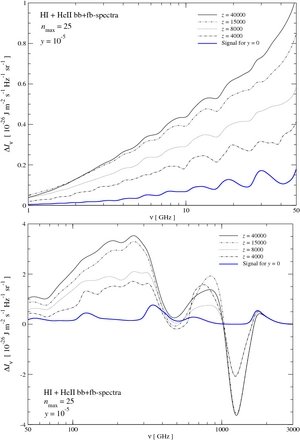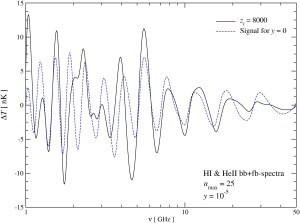|
|  |
The cosmological recombination (redshifts z~800-8000) of our Universe
is associated with the release of several photons per recombined hydrogen and
helium atom, leading to a small (ΔI/I~10-9-10-6)
residual CMB spectral distortion at low-frequencies. As reported earlier
( Research Highlight July 2007), the radiation from hydrogen recombination
(z~800-1800) due to the expansion of the Universe is redshifted more
than 1000 times, and today should be observable as quasi-periodic spectral
distortion of the CMB at sub-mm to dm- wavelength. Similarly, the recombination
of singly (z~1500-3000) and doubly (z~4500-8000) ionized helium
contributes to the total cosmological recombination spectrum, leaving unique
additional signatures in some spectral bands, as recently demonstrated in
collaboration with J.A. Rubino-Martin from the IAC in Tenerife. Observing
the cosmological recombination spectrum may open an alternative way to
determine the specific entropy of our Universe, the CMB monopole temperature, and the
pre-stellar abundance of helium. Research Highlight July 2007), the radiation from hydrogen recombination
(z~800-1800) due to the expansion of the Universe is redshifted more
than 1000 times, and today should be observable as quasi-periodic spectral
distortion of the CMB at sub-mm to dm- wavelength. Similarly, the recombination
of singly (z~1500-3000) and doubly (z~4500-8000) ionized helium
contributes to the total cosmological recombination spectrum, leaving unique
additional signatures in some spectral bands, as recently demonstrated in
collaboration with J.A. Rubino-Martin from the IAC in Tenerife. Observing
the cosmological recombination spectrum may open an alternative way to
determine the specific entropy of our Universe, the CMB monopole temperature, and the
pre-stellar abundance of helium.
For the computations of the cosmological recombination spectrum
it is usually assumed that the ambient CMB has a pure blackbody
form at all times. In this case practically no distortions are
created prior to the actual recombination epoch of the
corresponding atomic species, since atomic emission and absorption
processes balance eachother until then. However, it is well-known
that any release of energy in the early Universe should give rise
to some intrinsic spectral distortion of the CMB, which for energy
injection at z<2x106 should still
be present at some level even today.
More specifically, if energy was released at redshifts z<50000
the free-free process has already become very inefficient, only being
able to produce and destroy background photons at extremely low frequencies,
well outside the range of interest here. Furthermore photons are no
longer strongly redistributed over frequency by the scattering off free electrons.
Still due to the large total number of scatterings the small energy exchange
per scattering on average results in the upscattering of photons, leaving a
small decrease in the CMB brightness at low, and an increase at high frequencies.
This kind of distortion is usually referred to as y-type distortion (see Fig. 1),
and is also well-known in the context of the SZ-effect by clusters of galaxies.
It can be characterized by the Compton y-parameter, which depends on the
difference of the electron and photon temperature, and the number density of free electrons.
Measurements with the COBE spacecraft in the mid 90's have shown that at
present the whole-sky y-parameter should be smaller
than ~1.5x10-5, an observation that was awarded the Nobel Prize
in Physics, 2006. But what would one actually learn about the thermal history
of the Universe if still the value of y was non-zero at some lower level?
To answer this question it is important to realize that the y-type spectral
distortion is very broad and practically featureless. This makes it very hard
to understand when the distortion actually appeared, since different energy
injection histories lead to similar residual CMB distortions today. For example,
the integral contribution from unresolved SZ-clusters at low redshifts (z~1) is
expected to produce a y-type distortion at the level y~10-6.
On the other hand there are physical mechanisms
(e.g. dissipation of acoustic waves, decaying or annihilating matter)
that do lead to energy release at high redshifts (1000<z<50000),
also producing a y-type distortion, potentially at a similar level. Therefore the pure
existence of a y-type distortion in the overall CMB spectrum would not even allow
to distinguish pre- from post-recombinational energy release! This is were atomic
loops come into play, since they do lead to some narrow spectral features in the CMB
after energy release occurred. These features still carry information about the injection
process and in principle could allow us to separate low and high redshift contributions
to the y-parameter.
How does this work? If there was some energy injection at redshift z<50000
then after a very short time a y-type distortion is created. Since then
the CMB spectrum deviates from a pure blackbody, atomic emission and absorption
in general are no longer balanced, and atomic loops develop. These start with
the capture of a free electron by a nucleus, and end with the absorption of a
high frequency photon (for hydrogen and doubly ionized helium usually in the
Lyman-continuum), again liberating the electron. In between the captured electron
may cascade towards lower levels, releasing several photons. This process can help
to remove excess photons at high frequencies and produce quanta where they are
missing due to the intrinsic y-distortion (see Fig. 1). In this way one
absorbed high frequency photon can be split into several low-frequency quanta during
each loop (see Fig. 2 for illustration).
Scientists at the MPA have recently computed the cosmological recombination
radiation from hydrogen and doubly ionized helium, taking into account a
possible intrinsic y-type distortion of the CMB after some energy
injection. It has been shown that even for y~10-7-10-5
significant and non-trivial changes in the cosmological recombination spectrum appear,
which also strongly depend on the time of the energy release. The latter dependence
is shown in Fig. 3. Most striking are the huge change in the overall amplitude of the
distortion, both at low and high frequencies, and the appearance of a strong emission-absorption
feature at high frequencies. This feature would be completely absent if there was no
intrinsic y-distortion or if energy was released at z<800, meaning after
recombination finished. Observing it would clearly indicate some non-standard pre-recombinational
thermal history.
As discussed earlier ( Research Highlight July 2007) for measurements at low frequencies
one should compare the CMB brightness at different wavelength. Therefore from
the observational point of view it is very important that also the variable
component of the CMB signal is strongly depending on the details of the injection
process. In Fig. 4 we show the variable component in the CMB spectrum in the case when
a single energy injection occurred at z=8000. One can clearly see that in
comparison with the case of no or some post-recombinational energy injection
(curve for y=0), the peak to peak amplitude of the signal is increased.
Also non-trivial changes in the low-frequency variability appear, locally even leading
to additional spectral features. Research Highlight July 2007) for measurements at low frequencies
one should compare the CMB brightness at different wavelength. Therefore from
the observational point of view it is very important that also the variable
component of the CMB signal is strongly depending on the details of the injection
process. In Fig. 4 we show the variable component in the CMB spectrum in the case when
a single energy injection occurred at z=8000. One can clearly see that in
comparison with the case of no or some post-recombinational energy injection
(curve for y=0), the peak to peak amplitude of the signal is increased.
Also non-trivial changes in the low-frequency variability appear, locally even leading
to additional spectral features.
One can conclude that although the spectral features under discussion
here are very small, observing them would certainly open a way to distinguish
pre- from post-recombinational energy release, a question that may remain unsolved otherwise.
J. Chluba and R.A. Sunyaev
Publications
Jens Chluba, Rashid Sunyaev
"Pre-recombinational energy release and narrow features in the CMB spectrum"
submitted to A&A,
 arXiv:0803.3584 arXiv:0803.3584
Jose Alberto Rubino-Martin, Jens Chluba and Rashid Sunyaev
"Lines in the cosmic microwave background spectrum from the epoch of cosmological helium recombination"
accepted by A&A,
 arXiv:0711.0594 arXiv:0711.0594
|



